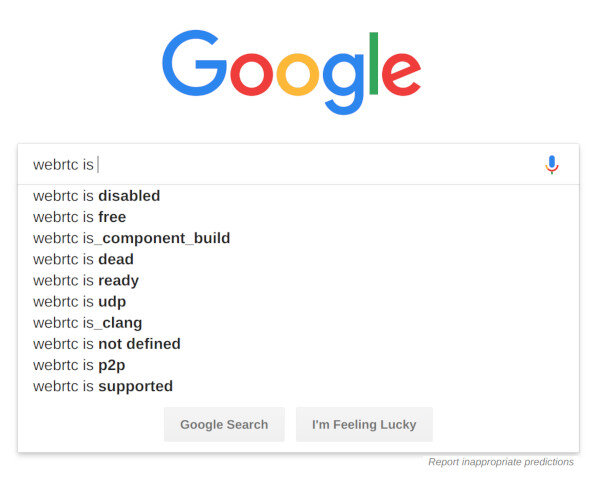This is going to be awkward. For me? WebRTC is an open source media engine with a publicly known JavaScript API that got implemented in browsers.
I’ve written a “what is WebRTC” article more than once. The most notable ones?
- What is WebRTC? – an article from 2017
- WebRTC FAQ: The 2018 Version
- WebRTC for Business People – a report that got updated in 2017, with a new 2019 edition coming real soon
- Advanced WebRTC Architecture Course – a full length paid for course that teaches WebRTC
This time, I wanted to check what Google thinks of WebRTC, so I started asking it:

Lets go one by one over these alternatives, trying to understand what are people looking for in their WebRTC.
WebRTC is disabled

Somehow, this got the highest ranking. VPN vendors doing their best with FUD and SEO here, in trying to get people to disable WebRTC in browsers.
Reminds me of the good old days when people disabled JavaScript in their browsers.
WebRTC does give access to the camera, microphone, screen and local IP address of a user. Most of it under the user’s own volition. You can use browser extensions to support local IP address “leaks”, while in Safari exposing local IP addresses requires user authorization of some sort as well.
Not sure how this got first place in “WebRTC is”.
WebRTC is free

Yes it is. Mostly. Somewhat. If you understand what “free” is.
You can go to webrtc.org and download it for free. You can even use it and modify it.
But then again, hosting a service isn’t free. Someone needs to pay for the network and electricity. Someone needs to do the coding.
Things brings a rather interesting mindset that I see in entrepreneurs and developers – they feel like using a third party framework or even a managed service should be free – or a lot cheaper than it is. So they go about developing it on their own, spending time and money on development (and a lot of times a lot more than it would have been just picking up a managed service instead).
That concept of free in WebRTC? It is mostly about removing barriers of entry for vendors. It isn’t about free video calling.
WebRTC is_component_build

Beats me how this got so high as a suggestion by google.
The build system in WebRTC is often challenging. That’s because Google maintains the main WebRTC open source project with the main purpose of being embedded in Chrome. Due to this, it is just part of the Chrome build process and scripts, and not a standalone product or library.
This part is probably the most painful in WebRTC for developers who need to modify or adapt it for native applications.
Still not sure why it ranks so high.
WebRTC is dead

It isn’t. Can’t even call it a grownup or a teanager.
Moving on.
WebRTC is ready

Yap. it is.
WebRTC is ready. Developers will still bitch and whine that it isn’t complete and changes all the time breaking things up, but at the end of the day – if you’re doing something with communications these days, WebRTC should be the first thing to look at before searching elsewhere.
WebRTC is udp
It is also TCP. With a dash of SCTP. With talks about making it QUIC. Go figure.
UDP is what WebRTC uses to send its media. It works well because TCP has this nasty habit of retransmitting things to make sure they get received. This retransmission thing doesn’t work well where what you’re sending is time sensitive (like media of an interactive conversation).
Not sure why this one is in the top 10 either.
WebRTC is_clang
Like is_component_build, is_clang is also a build/compiler related setting. In this case, deciding which C/C++ compiler to use with WebRTC.
And again, I am clueless as to how and why this is such a popular Google search for WebRTC is.
WebRTC is not defined

This is golden.
The search itself is most probably related to compilation and runtime errors of developers with WebRTC, where they post the error messages around the web in stack overflow, discuss-webrtc and other online forums – asking for help from fellow developers.
Yet…
WebRTC isn’t defined. Yet.
People primsed me WebRTC 1.0 since 2015. Maybe a year or two earlier. We are now in 2019, talking about things like WebAssembly in WebRTC. But we still don’t have WebRTC 1.0. We’re getting there, but it is still a draft. Will WebRTC 1.0 standardization complete in 2019? Maybe. But WebRTC is not defined. But it is ready. Go figure.
WebRTC is p2p
WebRTC is peer to peer.
You can send media directly from one browser to another (if network conditions allow). But you need to handle signaling in front of web servers, which is kinda centralized. And sometimes, sending media peer to peer won’t work media and has to be routed. And other times, you’ll want to send media towards a media server.
You can read more about it here – Get Over it: WebRTC isn’t Peer-to-Peer
WebRTC is supported

Something that is going to change meaning in 2019.
People used to ask “which browsers support WebRTC?” or “is WebRTC supported on X” where X is Internet Explorer, Edge or Safari.
Nowadays, we’re over that bit of a challenge, with the last gaps closing as well.
The shift of this one is going to be towards traditional voice and video services that are adding WebRTC support for guest access or for those who don’t want to install any apps.
In the last year or so, I’ve had to install a lot less applications for meetings I have with companies. It isn’t because we all use Google Meet – it is because almost all of the services (Zoom is the exception here) give WebRTC guest access. WebEx, GoToMeeting, Amazon Chime – all offer WebRTC support. So I can easily handle these calls without installing anything. And yes – WebRTC is supported.
What’s your WebRTC is search term?
I found this list of google search suggestions for WebRTC is quite interesting. Not exactly what I expected starting out.
For me, WebRTC is progress. It is the next step we’re taking in figuring out communications, and in that, it fills the role of one of the most basic building blocks we now have and use.
What about you? WebRTC is …
Looking to learn more about what WebRTC is? How about understanding about mesh, mixing and routing architecture? You should join me for this free webinar:

WebRTC is… still just a little confusing…Tsahi, i’m reading the book recommended by Loreto & Romano but the examples are outdated. With regards to the SDP signal – if peer A is on a webRTC application, but peer B is surfing youtube – How does peer B get notified of an offer? It would have to go to peer B’s email address right? — because there is no way of knowing peer B’s IP address. Please help.
Roudy,
WebRTC is definitely confusing.
The point you are missing is that there’s no signaling in WebRTC, so your question is irrelevant to WebRTC. It is up to you to answer this question. WebRTC starts when both users can send the SDP messages to each other *somehow*. That somehow can be an email, a push notification, a message in an app or on a web page you are on, etc.
If we were to meet, I’d probably send you a calendar invite with a link for example.
First of all, it is important to note that WebRTC can handle only incoming sessions. In other words, in your scenario A can not be notified of an offer. Only B can initiate a session and the app notifies A. The app can do this because the app has a persistent connection to A via Websocket or some such a mechanism. In SIP world this is called rendezvous service.
B initiates a session by clicking on a “call URL” that A has otherwise shared with B. This action connects B to the app server, which could establish a Websocket (or an equivalent) connection to B. The app server can use these connections and broker exchange of SDP Offer/Answer between B and A.
Finally, the app server can also broker exchange of other control messages related to the session, like the far end has placed mic on mute or far end has ended the session. I hope this clarifies.